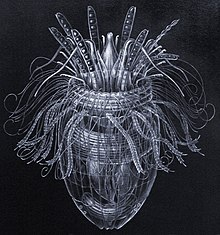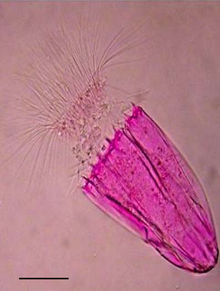Loricifera
| Loricifera | |
|---|---|

| |
| Pliciloricus enigmaticus | |
| Scientific classification | |
| Kingdom: | Animalia |
| Subkingdom: | Eumetazoa |
| Clade: | ParaHoxozoa |
| Clade: | Bilateria |
| Clade: | Nephrozoa |
| (unranked): | Protostomia |
| Superphylum: | Ecdysozoa |
| Phylum: | Loricifera Kristensen, 1983[2] |
| Order: | Nanaloricida Kristensen, 1983[2] |
| Families | |
| |
Loricifera (from Latin, lorica, corselet (armour) + ferre, to bear) is a phylum of very small to microscopic marine cycloneuralian sediment-dwelling animals that had been determined to be 37 described species, in nine genera,[3][4][5] but in 2021 has increased to 43 species.[6] Aside from these described species, there are approximately 100 more that have been collected and not yet described.[4] Their sizes range from 100 μm to ca. 1 mm.[7] They are characterised by a protective outer case called a lorica and their habitat is in the spaces between marine gravel to which they attach themselves. The phylum was discovered in 1983 by Reinhardt Kristensen, near Roscoff, France.[8] They are among the most recently discovered groups of Metazoans.[9] They attach themselves quite firmly to the substrate, and hence remained undiscovered for so long.[5] The first specimen was collected in the 1970s, and later described in 1983.[9] They are found at all depths, in different sediment types, and in all latitudes.[5]
Morphology[]
The animals have a head, mouth, and digestive system, as well as the lorica. The armor-like lorica consists of a protective external shell or case of encircling plicae.[10] There is no circulatory system and no endocrine system. Many of the larvae are acoelomate, with some adults being pseudocoelomate, and some remaining acoelomate.[9] Development is generally direct, though there are so-called , which differ from adults in several respects. As adults, the animals are gonochoric. Very complex and plastic life cycles of pliciloricids include also paedogenetic stages with different forms of parthenogenetic reproduction.[4] Fossils have been dated to the late Cambrian.[11]
Taxonomic affinity[]
Morphological studies have traditionally placed the phylum in the vinctiplicata with the Priapulida; this plus the Kinorhyncha constitutes the taxon Scalidophora. The three phyla share four characters in common – chitinous cuticle, rings of on the introvert, flosculi, and two rings of introvert retracts.[8][9] However, mounting molecular evidence indicates a closer relationship with the Panarthropoda.[12]

Evolutionary history[]
The loriciferans are believed to be miniaturized descendants of a larger organism, perhaps resembling the Cambrian fossil Sirilorica.[13] However, the fossil record of the microscopic non-mineralized group is (perhaps unsurprisingly) scarce, so it is difficult to trace out the evolutionary history of the phylum in any detail. The 2017 discovery of Cambrian Period Eolorica deadwoodensis may shed some light on the group's history.[14]
In anoxic environments[]
Three species of Loricifera have been found in the sediments at the bottom of the L'Atalante basin in Mediterranean Sea, more than 3,000 meters down, the first multicellular organisms known to spend their entire lives in an oxygen-free environment. Initially, it was thought that they are able to do this because their mitochondria act like hydrogenosomes, allowing them to respire anaerobically.[15][16] However, by 2021, questions arose as to whether or not they have mitochondria.[17]
The newly reported animals complete their life cycle in the total absence of light and oxygen, and they are less than a millimetre in size.[18] They were collected from a deep basin at the bottom of the Mediterranean Sea, where they inhabit a nearly salt-saturated brine that, because of its density (> 1.2 g/cm3), does not mix with the waters above.[18] As a consequence, this environment is completely anoxic and, due to the activity of sulfate reducers, contains sulphide at a concentration of 2.9 mM.[18] Despite such harsh conditions, this anoxic and sulphidic environment is teeming with microbial life, both chemosynthetic prokaryotes that are primary producers, and a broad diversity of eukaryotic heterotrophs at the next trophic level.[18]
Taxa[]
- Nanaloricidae Kristensen, 1983
- Nanaloricus Kristensen, 1983
- Armorloricus Kristensen & Gad, 2004
- Australoricus Heiner, Boesgaard & Kristensen, 2009
- Phoeniciloricus Gad, 2004
- Spinoloricus Heiner, 2007
- Pliciloricidae Higgins & Kristensen, 1986
- Pliciloricus Higgins & Kristensen 1986
- Rugiloricus Higgins & Kristensen, 1986
- Titaniloricus Gad, 2005
- Fujimoto, Yamasaki, Kimura et al., 2020[19]
- Urnaloricidae Heiner & Møbjerg Kristensen, 2009
- Urnaloricus Heiner & Møbjerg Kristensen, 2009
- Extinct taxa (unclassified)
- †Eolorica Harvey & Butterfield, 2017
- †Orstenoloricus Maas et al. 2009
References[]
- ^ Peel, John S.; Stein, Martin; Kristensen, Reinhardt Møbjerg (9 August 2013). "Life Cycle and Morphology of a Cambrian Stem-Lineage Loriciferan". PLoS ONE. 8 (8): e73583. Bibcode:2013PLoSO...873583P. doi:10.1371/journal.pone.0073583. PMC 3749095. PMID 23991198.
- ^ Jump up to: a b Kristensen, R. M. (September 1983) [2009-04-27]. "Loricifera, a new phylum with Aschelminthes characters from the meiobenthos". Journal of Zoological Systematics and Evolutionary Research. 21 (3): 163–180. doi:10.1111/j.1439-0469.1983.tb00285.x. ISSN 0947-5745.
- ^ Neves, Ricardo Cardoso; Reichert, Heinrich; Sørensen, Martin Vinther; Kristensen, Reinhardt Møbjerg (November 2016). "Systematics of phylum Loricifera: Identification keys of families, genera and species". Zoologischer Anzeiger. 265: 141–70. doi:10.1016/j.jcz.2016.06.002.
- ^ Jump up to: a b c Gad, Gunnar (17 June 2005). "Successive reduction of the last instar larva of Loricifera, as evidenced by two new species of Pliciloricus from the Great Meteor Seamount (Atlantic Ocean)". Zoologischer Anzeiger. 243 (4): 239–71. doi:10.1016/j.jcz.2004.09.001.
- ^ Jump up to: a b c Ruppert, Edward E.; Fox, Richard S.; Barnes, Robert D., eds. (2004). Invertebrate Zoology (7th ed.). p. 776. ISBN 978-0-03-025982-1.
- ^ Ricardo Cardoso Neves, Reinhardt Møbjerg Kristensen, Nadja Møbjerg, New records on the rich loriciferan fauna of Trezen ar Skoden (Roscoff, France): Description of two new species of Nanaloricus and the new genus Scutiloricus, PLOS One, May 5, 2021
- ^ Heiner, Iben. "Preliminary account of the Loriciferan fauna of the Faroe Bank (NE Atlantic)". Annales Societatis Scientiatum Færoensis Supplementum. 41: 213–9. Archived from the original on 27 December 2016. Retrieved 26 December 2016.
- ^ Jump up to: a b Heiner, Iben; Kristensen, Reinhardt Møbjerg (18 March 2005). "Two new species of the genus Pliciloricus (Loricifera, Pliciloricidae) from the Faroe Bank, North Atlantic". Zoologischer Anzeiger. 243 (3): 121–38. doi:10.1016/j.jcz.2004.05.002.
- ^ Jump up to: a b c d Kristensen, R. M. (July 2002). "An Introduction to Loricifera, Cycliophora, and Micrognathozoa". Integrative and Comparative Biology. 42 (3): 641–51. doi:10.1093/icb/42.3.641. PMID 21708760.
- ^ Heiner, Iben; Sorensen, Martin Vinther; Kristensen, Reinhardt Mobjerg (2004). Loricifera (Girdle Wearers) in Grzimek's Animal Life Encyclopedia Volume 1. New York, NY: Van Nostrand Reinhold Company. pp. 343–350.
- ^ "Discovery of new fossil from half billion years ago sheds light on life on Earth: Scientists find 'unfossilizable' creature".
- ^ Yamasaki, Hiroshi; Fujimoto, Shinta; Miyazaki, Katsumi (30 June 2015). "Phylogenetic position of Loricifera inferred from nearly complete 18S and 28S rRNA gene sequences". Zoological Letters. 1: 18. doi:10.1186/s40851-015-0017-0. ISSN 2056-306X. PMC 4657359. PMID 26605063.
- ^ Peel, John S. (March 2010). "A Corset-Like Fossil from the Cambrian Sirius Passet Lagerstätte of North Greenland and Its Implications for Cycloneuralian Evolution". Journal of Paleontology. 84 (2): 332–40. doi:10.1666/09-102R.1. JSTOR 40605520. S2CID 86256781.
- ^ Harvey, Thomas H. P.; Butterfield, Nicholas J. (30 January 2017). "Exceptionally preserved Cambrian loriciferans and the early animal invasion of the meiobenthos" (PDF). Nature Ecology and Evolution. 1 (3): 0022. doi:10.1038/s41559-016-0022. hdl:2381/38658. PMID 28812727. S2CID 22874770.
- ^ Fang, Janet (8 April 2010). "Animals thrive without oxygen at sea bottom". Nature. 464 (7290): 825. doi:10.1038/464825b. PMID 20376121.
- ^ Milius, Susan (9 April 2010). "Briny deep basin may be home to animals thriving without oxygen". Science News.
- ^ Snyder, Alison, Something wondrous, Axios Science, May 6, 2021
- ^ Jump up to: a b c d Mentel, Marek; Martin, William (6 April 2010). "Anaerobic animals from an ancient, anoxic ecological niche". BMC Biology. 8: 32. doi:10.1186/1741-7007-8-32. PMC 2859860. PMID 20370917.
- ^ Fujimoto, Shinta; Yamasaki, Hiroshi; Kimura, Taeko; Ohtsuka, Susumu; Kristensen, Reinhardt Møbjerg (14 November 2020). "A new genus and species of Loricifera (Nanaloricida: Pliciloricidae) from the deep waters of Japan". Marine Biodiversity. 50 (6): 103. doi:10.1007/s12526-020-01130-3. S2CID 228866331.
Further reading[]
![]() Data related to Loricifera at Wikispecies
Data related to Loricifera at Wikispecies
- Bernhard, Joan M.; Morrison, Colin R.; Pape, Ellen; Beaudoin, David J.; Todaro, M. Antonio; Pachiadaki, Maria G.; Kormas, Konstantinos Ar.; Edgcomb, Virginia P. (2015). "Metazoans of redoxcline sediments in Mediterranean deep-sea hypersaline anoxic basins". BMC Biology. 13: 105. doi:10.1186/s12915-015-0213-6. PMC 4676161. PMID 26652623.
- Danovaro, Roberto; Dell'Anno, Antonio; Pusceddu, Antonio; Gambi, Cristina; Heiner, Iben; Kristensen, Reinhardt Mobjerg (2010). "The first metazoa living in permanently anoxic conditions". BMC Biology. 8: 30. doi:10.1186/1741-7007-8-30. PMC 2907586. PMID 20370908.
- Fox-Skelly, Jasmin (25 January 2017). "BBC Earth: There is one animal that seems to survive without oxygen". BBC News.
- Heiner, Iben (2008). "Rugiloricus bacatus sp. nov. (Loricifera ‐Pliciloricidae) and a ghost‐larva with paedogenetic reproduction". Systematics and Biodiversity. 6 (2): 225–47. doi:10.1017/S147720000800265X. S2CID 85855659.
- Ramel, Gordon. "The Brush Heads (Phylum Loricifera)".[self-published source?]
- "Can animals thrive without oxygen?". Woods Hole Oceanographic Institution. 28 January 2016.
- "Discovery of new fossil from half billion years ago sheds light on life on Earth". Science News. Retrieved 19 April 2017.
- Loricifera
- Animal phyla
- Extant Cambrian first appearances